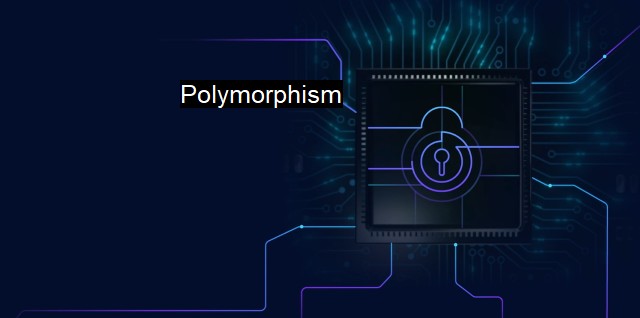What is Polymorphism?
Unmasking Polymorphic Malware: An Analysis of Adaptive Cybersecurity Threats and How Antivirus Software Responds
Polymorphism is a concept derived from the Greek words 'poly' meaning many, and 'morphe' meaning forms, thus denoting many forms. more specifically in antivirus mechanisms, polymorphism refers to a technique used by cybercriminals to alter the code of a malware, virus or Trojan, and thus avoid detection through antivirus software. The name is derived from the malware's ability to change, or have 'many forms', but retaining their destructive functionalities.Invisible to most users, antivirus software continually scan systems, seek out malicious entities, and strive to protect us from intrusive invaders. The primary way antivirus software identifies potential threats is by looking for known patterns of data—otherwise known as signatures— that correspond to existing forms of malware. But like any game of strategy, opponents can adjust their tactics, and in the world of cyber threats, polymorphism is one of the cybercriminals’ most cunning responses. It is their strategy for obfuscating their malware’s signature, and hence, evading detection.
Modern virus coding incorporates the use of polymorphic code which, when enabled, allows the virus to mutate while keeping the primal algorithm unchanged. The metamorphic transforming procedure uses obfuscation to change the virus body, then it executes permutation techniques and insertion of garbage codes during each iteration and thus can propagate in different forms each time. An example of polymorphism in malicious use includes the creation of sophisticated, multifaced viruses for things like ransomware attacks, where the encryption code changes every time it passes through a system, thus making the malicious software nearly impossible for basic antivirus software to detect or eradicate.
Polymorphic malware intersect with the Internet of Things (IoT) domain as well where their rapidly mutable quality poses a significant challenge. Take malware such as the Mirai botnet for instance, known for compromising IoT devices, underwent polymorphic modifications to compromise more devices, magnifying the attack manifolds. Similarly, attacks on financial institutes, for card skimming or to illicitly acquire banking information also frequently employ polymorphic codes.
Dealing with polymorphic viruses can be quite taxing, for it goes beyond traditional interpreter and instruction detections. This calls for advanced cybersecurity techniques of artificial intelligence and machine learning enabled antivirus software that auto-learn to detect and fight against the transformed malware. These heuristics-based detectors would be paired with dynamic execution tracing and stringent behavior blocking technology to provide maximum online safety.
In an encryption-based polymorphic malware, the encryption algorithm also keeps changing, adding another layer of complexity. Here static scanners do not suffice, it necessitates designed polymorphic engines that apply algorithms and utilise cryptographic techniques to tackle the everchanging malware.
Advanced persistent threat (APT) activities, often nation state-driven stealth attacks, employ polymorphism to go unnoticed longer while siphoning off information or creating disruptions, as observed regularly in cyber espionage attempts, more reason why efficient polymorphic escorts are needed to ensure cybersecurity.
To wrap up, polymorphism may have originally been prescriptive, found in biological taxonomy or object-oriented programming, but in the current cybersecurity context, it is anything but benign. Polymorphic malware, with their chameleon-like disguise to evade antivirus scans, pose a direct threat to network security. Therefore, the key to mitigating such innovative virus saturation lies in combining traditional defense mechanisms with next-generation technologies dedicated to incessant cyber protection, while promoting conscientious network navigation.

Polymorphism FAQs
What is polymorphism in cybersecurity?
Polymorphism is a technique used by malware to evade detection by anti-virus software. It involves changing the code structure of the malware while keeping its functionality intact. This makes it difficult for anti-virus software to identify and block the malware.How does polymorphism work?
Polymorphism works by using an algorithm that generates a unique code for each instance of the malware. The code is different each time the malware infects a new system. This makes it difficult for antivirus software to identify the malware through signature-based detection.What are the types of polymorphism?
There are two types of polymorphism - static and dynamic. Static polymorphism involves changing the code structure of the malware before it is executed. Dynamic polymorphism involves changing the code structure of the malware during runtime.How can anti-virus software detect polymorphic malware?
Anti-virus software uses different techniques to detect polymorphic malware, including behavior-based detection and heuristics analysis. Behavior-based detection looks at the actions of the malware rather than its code structure. Heuristics analysis looks for patterns in the malware's behavior that may indicate it is polymorphic. Additionally, some anti-virus software can recognize the common techniques used by polymorphic malware and identify them based on their behavior.Related Topics
Virus polymorphism Malware analysis Signature-based detection Behavioral-based detection
| | A | | | B | | | C | | | D | | | E | | | F | | | G | | | H | | | I | | | J | | | K | | | L | | | M | |
| | N | | | O | | | P | | | Q | | | R | | | S | | | T | | | U | | | V | | | W | | | X | | | Y | | | Z | |
| | 1 | | | 2 | | | 3 | | | 4 | | | 7 | | | 8 | | |||||||